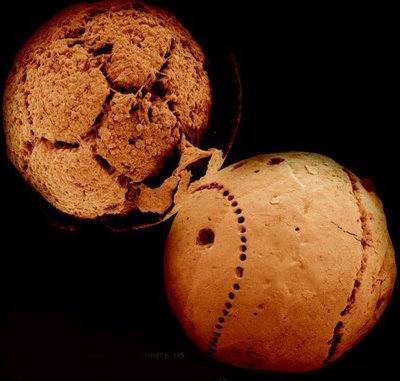
Animal embryo fossils from the Ediacaran Doushantuo Formation in South China. Photo by Shuhai Xiao.
From Xinhua On-line: A recent fossil discovery in South China, combined with fossils found in 1998 and 2000 could reveal how the earliest known egg-laying organism developed from embryo to adulthood.Researchers discovered thousands of 600-million-year-old fossilized embryos in the Doushantuo Formation nine years ago. Two years later, the same team unearthed fossils of a tubular coral-like animal, named Megasphaera ornata, which appeared to be adult versions of the embryos discovered earlier.
The case for a relationship between the two fossil types grew stronger following the recent discovery of about 80 intermediate-stage fossils that have traits in common with both groups.
On the outside, the early and intermediate stage embryos look very similar. They are about the same size -- about 0.02 inches wide or about as big as a grain of sand -- and both have similar outer coverings, or embryonic envelopes.
Using microCT scans found 3D structures that look like grooves on a screw.
Traces of these coils are also found on the external coverings of the adult fossils. Some of the intermediate embryos also appeared to be unfurling, encouraging the speculation that if the process had continued, the embryos would distend like a stretched slinky or a flattened fuselli noodle into the tubular adult form.

Listen to or download the Jan. 27, 2007, interview with Dr. Shuhai Xiao on CBC’s “Quirks & Quarks” HERE. (Scoll down to find the link)